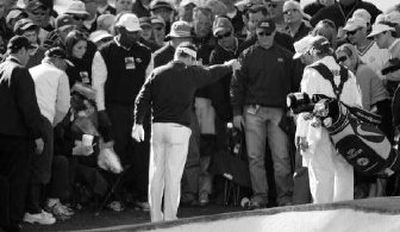It’s only for the Masters

AUGUSTA, Ga. — Tiger Woods called it the hardest Masters he had ever seen, and the numbers back him up.
There were twice as many bogeys as birdies, and that doesn’t account for the 230 double bogeys or worse. There were only 34 rounds under par all week. Perhaps the most surreal sight at Augusta National was the large leaderboard behind the 18th hole awash in green numbers, which represent over par.
Zach Johnson finished at 289, matching the Masters record for the highest winning score.
And we’re only getting started.
Johnson’s score was the highest to win a major since Paul Lawrie shot 290 and won a playoff in the ‘99 British Open at Carnoustie, long considered the toughest links in the world, known in British tabloids as “Car-nasty.”
That’s where these guys are headed this summer.
In between is a trip to Oakmont. The last time the U.S. Open went there, Ernie Els shot 74 in a playoff and still won.
By the time they get to the PGA Championship, Southern Hills might seem like Indian Wells.
Majors are supposed to be hard.
And yes, that includes Augusta National.
Along with being the highest-scoring Masters in more than 50 years, it also was one of the most quiet Masters in recent memory.
The sound at Augusta National is as inherent as the sights. It was muted for much of the week as the world’s best players hung on for dear life on a bone-dry course, in swirling wind, in weather more suited for a Green Bay Packers game in late October and on greens so firm it was difficult to get the ball close for birdie, much less par.
The degree of difficulty was indicative not only by the scores, but by the starting times Sunday. The last group teed off at 2:15 p.m., 45 minutes earlier than usual because it was taking so long to putt out.
Does all this mean the Masters was a disaster?
Hardly.
Augusta National is known for its explosive nature, particularly on the back nine on Sunday. It was a double eagle by Gene Sarazen on the 15th hole in 1935 that put this tournament on the map. It was a 30 on the back nine by Jack Nicklaus in 1986 that for many remains the most famous Sunday in Masters history. Phil Mickelson won his first Masters with five birdies over the final seven holes.
Sometimes, conditions don’t allow for such fireworks.
That alone doesn’t make the Masters any less memorable.
An hour before the final round, Jim Nantz and CBS Sports showed a colorized broadcast of the 1960 Masters won by Arnold Palmer. The winning score was 282. Palmer didn’t birdie either of the par 5s on the back nine, but rallied to win with a 30-foot birdie on the 17th and a 6-iron to about 6 feet for birdie on the 18th.
What makes the Masters so special among the four majors is returning year after year to Augusta National. It might be longer. Sometimes it’s sloppy after a week of rain. Sometimes the dogwoods and azaleas blaze a little brighter.
It’s still the Masters.
Golf fans know every hole on the back nine at Augusta National, and since TV coverage was expanded in 2002, they are starting to know every hole on the front. Some years it will be easier to make birdie, some years it will be tough to make par.
This was the latter.
It would be easy to suggest that Augusta National ruined its major by adding nearly a quarter-mile of length since 2001, but that would be measuring the Masters based only on this year.
What happened was a perfect storm — no measurable rain during the week, or even the weeks before the Masters; gusts up to 25 mph, swirling through the trees, as always; weather so cold on the weekend that the wind chill never got into the 50s on Saturday, and fans were kept outside the gates for an hour Sunday morning until the frost melted.
The last time no one broke par at the Masters was in 1966, when Nicklaus, Tommy Jacobs and Gay Brewer finished at even-par 288. Nicklaus won the next day in an 18-hole playoff, and he wrote about the conditions in his autobiography.
He said a cold, dry winter had left the fairways sparse. The club decided not to mow too short, which led to flier lies from the fairway. Compounding the problem was the rock-hard greens, which made it difficult to get any shots anywhere near the hole. And wind gusts were 30 mph.
“One thing was certain as we wound up practice,” Nicklaus wrote. “There would be no record scores this year.”
Even with scoring so high, the Masters still had its share of flurries and failures, of eagles and double bogeys.
Rory Sabbatini’s eagle putt on the eighth hole was from 75 feet, although it probably rolled closer to 100 feet by the time it traveled left onto the fringe, then veered right back to the hole. Woods hit 5-iron to the top shelf on the par-5 13th, then went from screaming, “God, bite!” to slapping hands with his caddie when it stopped 3 feet from the pin.
Luke Donald holed a 30-yard pitch for eagle on the eighth, only to follow with a triple bogey when he chipped three times before keeping his ball on the ninth green. Padraig Harrington found water on the 15th in three of four rounds, and played the par-5 in 5 over for the week.
It became cliche during the week to say, “I went to the Masters and the U.S. Open broke out.”
But it wasn’t like that.
The Masters will return to Augusta National year after year. And there was one other sign that you knew this wasn’t a U.S. Open.
Tough as it was, no one complained.